During my research into vintage Japanese drawing software, I came across some devices that had built in sketch or handwritten memo functions. I bought a couple of them to see if they did anything cool or interesting. These sorts of devices are pre-internet, so there’s not much about them online, and they can’t be emulated, so the only way to find out what they do is to get first hand experience by reading the manual or, better, using one yourself. It’s difficult to find these devices in working condition, as most of them have screen polarisers that have gone bad over time, but if you’re lucky you can find one.
1994
One such device I bought was the Sharp PI-4000, from 1994. This is a pocket computer that rolled out of Sharp’s involvement in the development and manufacturing of Apple’s Newton MessagePad. In 1993 Sharp did their own licenced version of the Apple Newton MessagePad H1000, the Expert Pad PI-7000, but just like Apple’s device it wasn’t as successful as they’d hoped. But before that, in 1992, they’d made a device called the PV-F1 which was the first touchscreen-only PDA. After the Expert Pad failure, Sharp took another attempt at the concept and came up with the PI-3000 in 1993. This solved all the problems with the PV-F1, most notably size and cost. The device I have, the PI-4000, was released a year later and features higher memory capacity. The PI-3000/4000 devices could transfer data via infrared, connect to a modem to send faxes, and by the PI-5000 in 1995 could connect to cell phones to send emails. They all use a simplified—but still quite complicated—version of the multi-window operating system that had been developed for the PV-F1.

So I was trying out the PI-4000, the memo function is pretty cool allowing you to draw in different dither shades and pen widths, and use stamps to add symbols to your memo. These are mostly map-related things like road and rail junctions, buildings, and train stations. Pretty cool. Then I tried typing some messages on the device and as I explored the myriad of keyboard input mechanisms I came across something rather familiar (sorry about the awful photo—it’s the best I could do, honest—the screen is very reflective and the pixels are so far from the backing they cast individual shadows!):
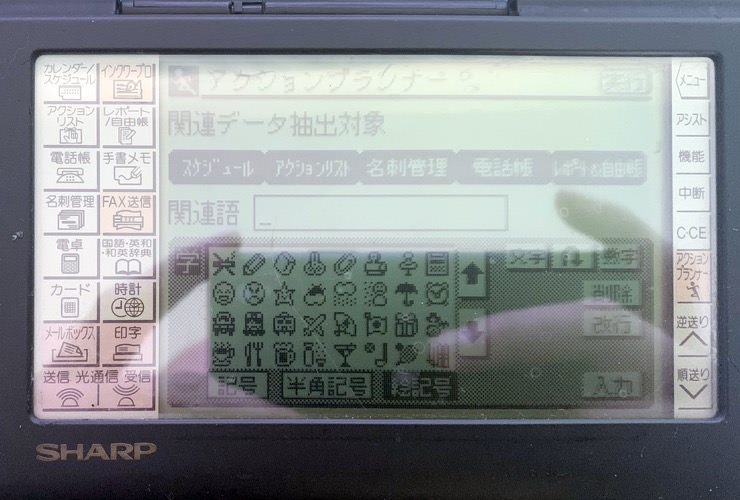
At this point, I couldn’t quite believe what I was seeing because I was under the impression that the first emoji were created by an anonymous designer at SoftBank in 1997, and the most famous emoji were created by Shigetaka Kurita at NTT DoCoMo in 1999. But the Sharp PI-4000 in my hands was released in 1994, and it was chock full of recognisable emoji. Then down the rabbit hole I fell. 🕳️🐇

1990
A little more reading, and a tip from my friend @chamekan on Twitter, unearthed the fact that the NEC PI-ET1 in 1990 also contained emoji1. I also found a collector who owned a device, and we’ll hear more from them later on. The device is literally the coolest thing you’ve ever seen. With system software written by video game developer Hudson Soft its character set features emoji that can be typed inline, and it also features a “montage function” that allows you to create faces for each of your contacts—15 years later we’d see something similar in Mii on Nintendo Wii in 2006. The emoji on this device are a lot less well designed, in my humble opinion, than those on the Sharp devices.

A word about word processors
By now I was in contact with Keith at Emojipedia, who mentioned that he remembered a Sharp device with emoji, a word processor. I found one in the Sharp WD-A521, from November 1990, which featured higher resolution versions of the emoji designs found on my Sharp PI-4000.
There’s also the Panasonic FW-U1S50 from 1990, which contains 110 famiiar emoji under a section called “illustrations”, and also contains another 99 “audio/visual” symbols some of which coincide with modern emoji.
Perhaps there are other word processors from around that time that also contain emoji? I understand from my friend Izumi Okano that Japanese software developer Enzan-Hoshigumi, most famous for their Macintosh software and clipart, had created pictograms for one of the Canoword word processors around 1986. So at this point I’m thinking, why would the emoji on a word processor be ignored on the timeline of emoji history? Was there anything else being ignored?
Before cell phones became prevalent there were pagers, or beepers, in Japan these were known as Pocket Bell. Initially they would only beep and show a number, and people would use “beeper slang” to form words by using numbers whose pronunciation was similar to words and syllables. Necessity is the mother of invention! Eventually pagers would be able to send and receive text. It was perhaps only natural that emoji find a home on these devices, with the most notable being the heart ❤️ emoji. But the date of this transition is 1995, which is earlier than the SoftBank emoji from 1997 but later than my Sharp PI-4000 device.
A note about beepers
As an aside, it’s interesting to understand how emoji were typed on pagers/beepers. They weren’t selected using a picker, which would have required cycling through a huge range of characters, but rather typed in numeric digits which narrows the cycling down to far less characters.
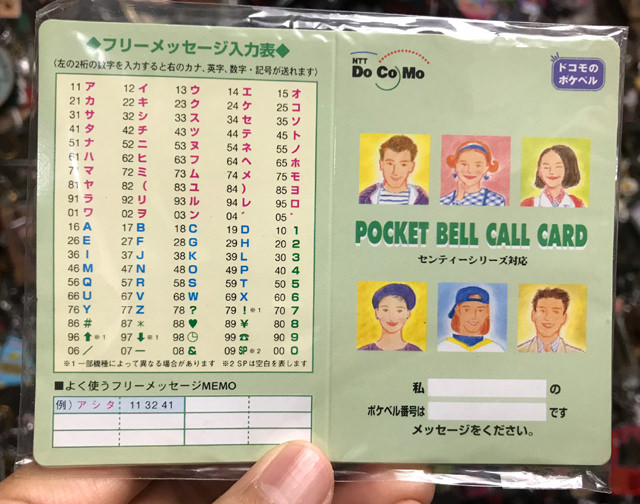
The numeric code:
21 91 15 24 12 23 78
…would map to:カラオケイク?
…which means:KARAOKE?
Wild. Typing text this way must have felt like programming machine code directly in hexadecimal!
What makes it emoji?
I was chatting to my friend Louie Mantia, who has designed many emoji in his career, discussing the earlier emoji I had found in my 1994 device. Louie asked me to confirm that I could type emoji inline with text, giving me the example W😲W, which was his criteria for the symbols to qualify as emoji. If I couldn’t do that, he suggested we could only consider the symbols as icons.
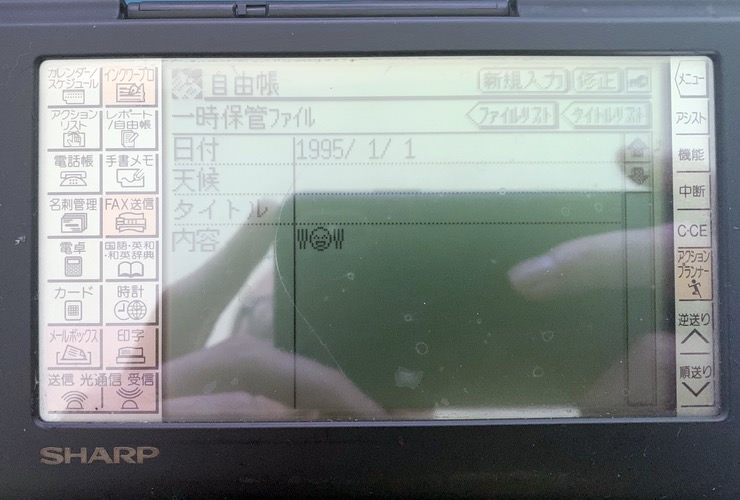
So if I can type them inline amongst text on my device from 1994 that was capable of connecting to other devices and sending messages, then surely they should be considered the first emoji? Why do we, currently, only count emoji as emoji if they’re on a mobile phone? I’m also wondering when these emoji might have been designed. Were they created in 1994 for the PI-4000, in 1993 for the PI-3000, or earlier for another device?
1988
So I kept looking. I was aware of another line of Sharp devices, electronic organisers, known as the Bware range in Japan and Wizard in the USA. These were pretty popular at the time, so much so that the USA device even got it’s own episode of Seinfeld in 1998. I’d come back into contact with these devices just last year as they had the interesting capability of being able to play video games stored on solid-state application “IC” cards. You can play a version of Tetris by BPS that is quite different to the Game Boy version, and both were released in 1989. You can also play versions of Sokoban by Thinking Rabbit, and Fortress by SSI/Victor, amongst others.
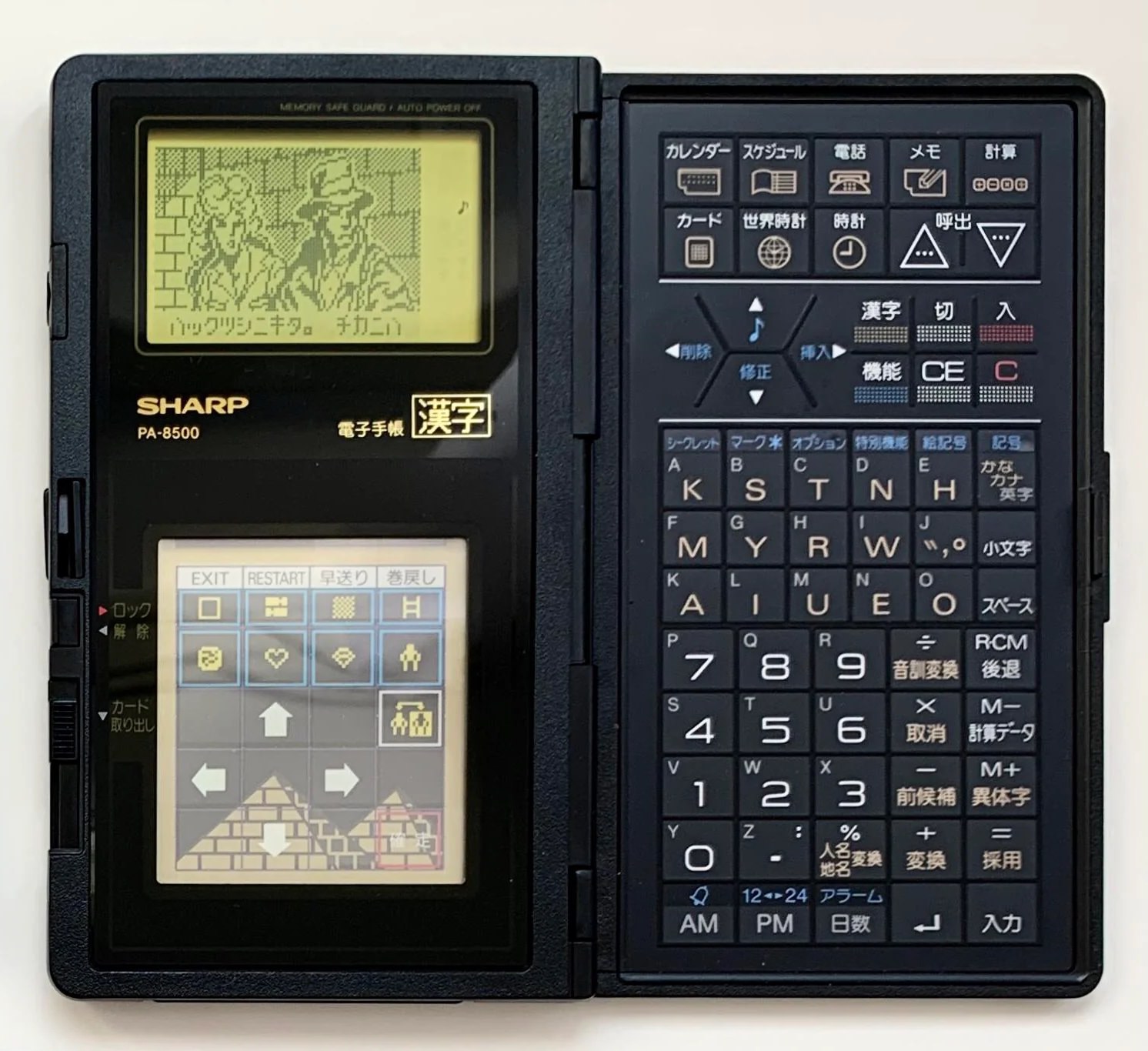
Thanks to a collector, Akuji, I was able to confirm that the Japanese PA-8500 device, released in 1988, contains emoji2 similar in design to those found on my PI-4000 and on the WD-A521. When redrawing these it was obvious that all the Sharp emoji sets are based on the same master design. (I’d love to know more about the Sharp artwork if anybody knows anything.)

How old is an emoji?
At this point we’ve wiped almost a decade off the creation date of emoji, but can we go further? Is there a way to date a set of emoji? In Japanese 絵文字 means emoji.
If we think about the PA line of devices, the PA-8500 was released in 1988, and it’s predecessor the (emoji-less) PA-7000 was released in 1987. So maybe the emoji set was created around this time? We can get closer by looking at a couple of characters present in the emoji that give us a clue to the date of creation. That is indeed the case with the Sharp PI-4000 and WD-A521.
The characters ○金 and ○ビ (maru-kin meaning rich/successful/winner and maru-bi meaning poor/unsuccessful/loser) were invented by the author Kazuhiro Watanabe in 1984 in his book Kinkonkan which was later made into a movie. These were quickly accepted into Japanese vocabulary, winning the 84年の日本流行語 (Japanese Buzzwords Award 1984). And they are right there in the Sharp PI-4000 emoji, represented as characters enclosed in circles. They were in common use throughout Japan’s bubble-era, 1986-1991, but eventually fell out of fashion and are now considered obsolete. It’s interesting to note that they are not featured in either the 1997 SoftBank or 1999 NTT DoCoMo emoji sets.
1984
Once you accept that emoji existed in the 1980s, more things come to light. The Ishii Award 「石井賞創作タイプフェイスコンテスト」 was a typeface design contest organised by the community of type designers in 1970. By 1984 it was in its 8th year. Yutaka Satoh of Type-Labo proposed a typeface consisting of emoji. Because they weren’t on screen they were created by arranging dots in various shapes, but they are recognisably emoji.
Coincidentally, I used a hybrid of this sort of approach when I added emoji to my game YOYOZO in September 2023: I plot the emoji as points but define them on a pixel grid.

In Matt Alt’s book “The Secret Lives of Emoji: How Emoticons Conquered the World”, there is a brief mention of ASCII emoticons on the Japanese internet (JUNET) in 1984, and then it fast forwards to 1995 to begin talking about the Pager, missing a decade of emoji usage in the process.
In the Yakumono typeface, created by Yutaka Satoh (TYPE-LABO), we can clearly see many of the key emoji that would persist throughout the years: smiley faces, food, drink, cigarettes, sweat, umbrella, paperclip, lips, envelope, and most interestingly the (not smiling) pile of poo. This typeface received an honourable mention at the awards. Some 40 years later, I think it’s safe to say it deserved more. 🏆
1979
We can see emoji in the character sets of Japanese home computers such as the Sharp MZ-80K, which included a UFO, smiley faces, stick figures, car, snake, and more. I won’t include them here but you can click the above link to see some in a PDF. 💾
1965
“Full Moon With Face”, also known as BA-90 which was listed in a book of typesetting symbols, published by Sha-ken in 1965. A smiling moon is still present in the emoji set today. 🌝

1959
CO-59 is a character set created in 1959 for exchange of data between Japanese newspapers. In it is included a symbol of a baseball, which again is still present in emoji ⚾️ and at Unicode codepoint U+26BE ⚾︎ today.
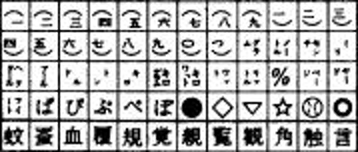
Comparing Emoji
I was interested in how the emoji that I have redrawn compared to the 1997 SoftBank and 1999 DoCoMo sets, and an early Pocket Bell, so here’s a little table.
|
Sharp PA-8500 |
NEC PI-ET1 |
Sharp PI-4000 |
Pocket Bell R-FAHC |
SoftBank | NTT DoCoMo |
|
|---|---|---|---|---|---|---|
| Year | 1988 | 1990 | 1994 | 1995 | 1997 | 1999 |
| Quantity (approx) | 100 | 130 | 170 | 7 | 90 | 176 |
| Resolution | 16×16 | 16×16 | 12×12 | 5×7 | 12×12 | 12×12 |
Conclusion
So what does this all mean? I’d say mostly that the history emoji isn’t as clean cut as you might have thought. You can decide for yourself on what you consider to be the first emoji. It depends on our own personal definition, so there is no right or wrong answer. 😎
Personally, I define the start date of emoji as the point in time when sets of these symbols first appeared for use whilst composing text. I don’t think the timeline should start at mobile phones, as this feels like a somewhat arbitrary decision that dismisses a lot of history. It’s like saying music only began to exist from the moment it could be recorded and listened to without the actual muscians being present. 🤔
As to whether the timeline of emoji history will be rewritten with this knowledge, it’s difficult to say. Much of this falls in the grey area of happening around the time the internet was taking hold, plus most things about the origin of emoji are in Japanese language, so there are unlikely to be sources Wikipedia would consider verifiable enough. The best we could do is quote the pages of the manuals for devices, and for the rest hope that there’s some record in Japanese literature that could be cited.
I won’t be running the Wikipedia editing gauntlet, but if you do please let me know how it goes! 🧨

Terms of use
I painstakingly recreated the emoji sets on this page, pixel by pixel, over many days of hard work. I even went so far as adding a new tool to the pixel art app I use, so as to make the task of redrawing hundreds of emoji a little less daunting. Feel free to utilize the emoji images, just remember to credit @gingerbeardman and include a link to this page. With one exception: I object to the use of these images for the purpose of creating NFTs. Thanks for your understanding!
Originally published: 2024-05-10
--
Buying me a coffee helps create more content like this!
--
Comments: @gingerbeardman